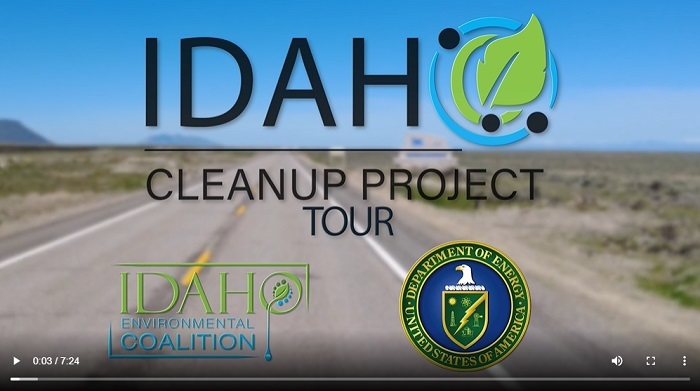 IDAHO FALLS, Idaho – In the era of the COVID-19 pandemic, the EM program at the Idaho National Laboratory (INL) Site recently filmed a virtual video tour of its facilities as an alternative to in-person visits.
“The goal was to make this virtual tour as realistic as possible,” said Dana Kirkham, strategic initiatives director for EM cleanup contractor Idaho Environmental Coalition. “We wanted to give those who watched the video the same look they would have if they were actually touring the site.”
A video camera was affixed to an automobile as it navigated roads through the 890-square-mile DOE site. This served to create the impression the viewer was along for the ride.
Before the pandemic, EM conducted more than 40 major INL Site tours per year with environmental interest groups, congressional staffers, Idaho elected officials, interns, foreign nationals and DOE headquarters officials.
Beginning in early 2020, EM curtailed all tours. As the COVID-19 community infection rate dropped, tours were held sparingly.
The tour video shows EM work at the former Fuel Reprocessing Restoration Facility at the Idaho Nuclear Technology and Engineering Center (INTEC), where workers built a mock-up to simulate the retrieval of radioactive waste known as calcine. They also constructed a system there for actual waste retrieval from storage bins in the Calcined Solids Storage Facility prior to the facility’s closure at INTEC.
Also featured is the Integrated Waste Treatment Unit (IWTU), constructed to process 900,000 gallons of radioactive liquid waste into dry granular solids that will be packaged in stainless steel canisters and stored in concrete vaults. The waste was generated during decontamination activities following spent nuclear fuel reprocessing. The IWTU is scheduled to begin radiological operations this fall.
The tour also makes stops at the Idaho CERCLA (Comprehensive Environmental Response, Compensation and Liability Act) Disposal Facility, Radioactive Waste Management Complex, Advanced Mixed Waste Treatment Project, and planned decontamination and demolition work at the Naval Reactors Facility.
“To physically see the facilities highlighted in the video and work being conducted within each one would take someone an entire day or longer to see,” said Kirkham. “The virtual tour provides the viewer with everything they’d see on an actual tour without the hours of driving, passing through security posts and walking through active operational areas.”
As EM work is completed, the virtual tour video and its script will be updated.
“It’s the next best way to show people our cleanup progress and to keep the public and our employees safe,” said Kirkham.
Click here to watch the virtual tour.
-Contributor: Erik Simpson
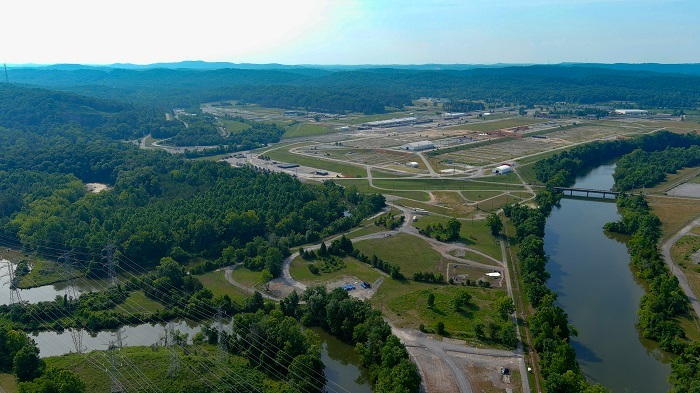 EM’s cleanup has transformed the East Tennessee Technology Park (ETTP), pictured here, from a former uranium enrichment complex into a private industrial park home to many new businesses, conservation areas and portions of the Manhattan Project National Historical Park. The ETTP cleanup has also led to a newly revised map of emergency sectors in the Oak Ridge area.
OAK RIDGE, Tenn. – EM’s progress is transforming more than the landscape; it’s also changing an important map in Oak Ridge.
DOE and the Tennessee Emergency Management Agency (TEMA) developed an emergency sector map for the Oak Ridge area designed in case a potentially dangerous event occurs at one of DOE’s three major sites within Oak Ridge — the East Tennessee Technology Park (ETTP), Oak Ridge National Laboratory (ORNL) and the Y-12 National Security Complex.
The map, which was created by establishing five-mile radiuses around each of those three sites, was recently updated since all hazards with potential offsite impacts have been eliminated from one of them — ETTP.
EM’s work at ETTP removed a former uranium enrichment complex — a world first — that had been shuttered since the 1980s. That two-decade cleanup involved crews tearing down more than 500 old, contaminated structures that together had a total footprint that spanned an area comparable to 225 football fields.
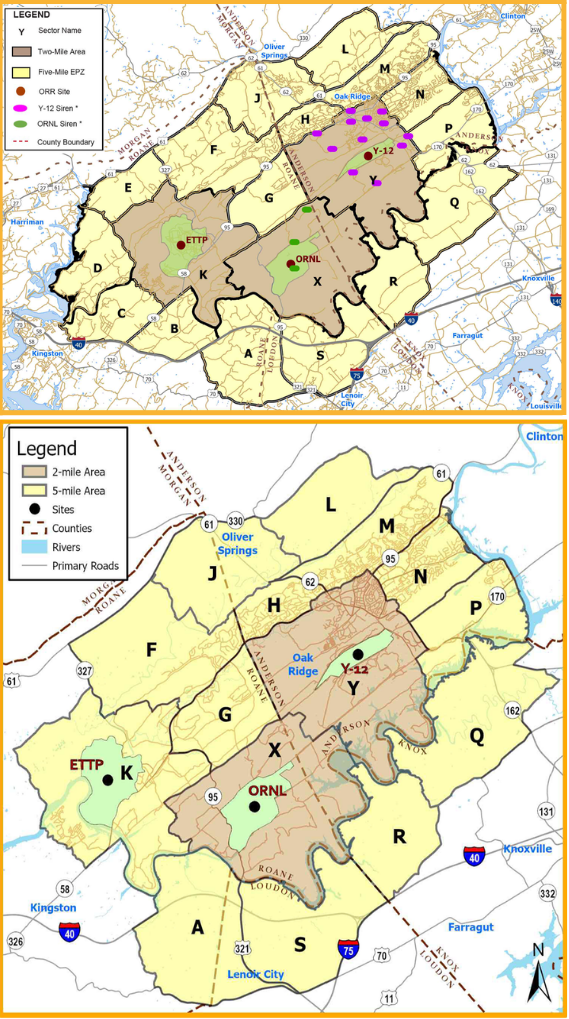 With EM’s cleanup at the East Tennessee Technology Park (ETTP) at Oak Ridge largely complete, four emergency sectors for the Oak Ridge community have been eliminated from an emergency sector map created by DOE and the Tennessee Emergency Management Agency. The previous map, at top, compares with the updated map, immediately above, which shows the removal of sectors B, C, D and E around ETTP.
Removal of the risks at ETTP led to the elimination of four emergency planning zones for the Oak Ridge community. That means homes, businesses and schools on the city’s west side near ETTP are no longer included in the emergency sectors.
"To reduce the footprint and to make it more efficient, we've eliminated four of the sectors,” said Roger Thompson, a program manager with TEMA. “That way we can concentrate more of our resources to areas that are outside the five-mile area of ORNL and Y-12, which still have hazards that can get offsite."
The removal of all potential offsite risks from ETTP and the elimination of four emergency planning sectors is a tangible measure of EM’s impact.
With major cleanup complete at ETTP, cleanup crews are busy addressing hazards and risks at the other two DOE sites in Oak Ridge — Y-12 and ORNL.
The ongoing work to address and remove hundreds of old, contaminated buildings at those sites will continue enhancing safety for the region.
In addition to updating the emergency sector map, DOE and TEMA have released an updated booklet informing the community how to remain safe and prepared in the event of an emergency. That booklet is available on the Y-12 and TEMA websites.
-Contributor: Ben Williams
 Hanford Mission Integration Solutions staff members Todd Freeland, left, and Adam Wittner disconnect electrical connections to facilities that once supported the former Plutonium Finishing Plant at the Hanford Site.
RICHLAND, Wash. – Following completion of demolition and other cleanup work at the former Plutonium Finishing Plant (PFP) at the Hanford Site, EM contractor Hanford Mission Integration Solutions (HMIS) recently finished disconnecting decades-old lines once used for water, sewer, electrical and technical support at surrounding facilities.
This included isolating and draining water lines, capping them off and making sure there were no leaks. Water drained from the lines was reused across the Hanford Site.
“Disconnecting and removing support facilities is one of the important final steps following PFP demolition and cleanup,” said Tom Teynor, EM Richland Operations Office (RL) federal project director for PFP. “Continued progress demonstrates the One Hanford mission to safely complete critical risk-reduction projects.”
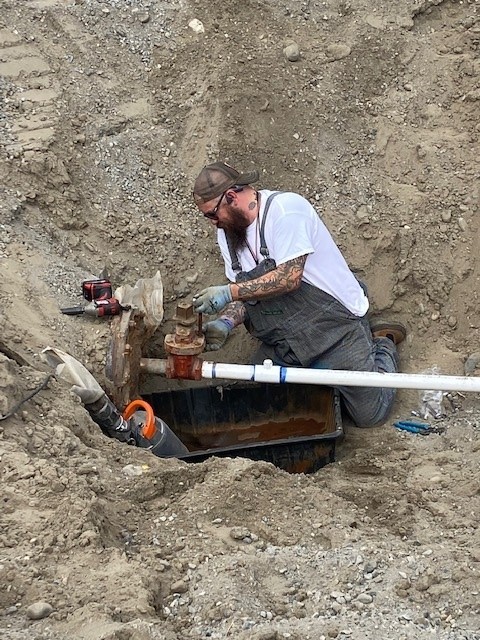 |
|
Nate Steel with Hanford Mission Integration Solutions disconnects water lines following completion of cleanup work at an area on the Hanford Site. |
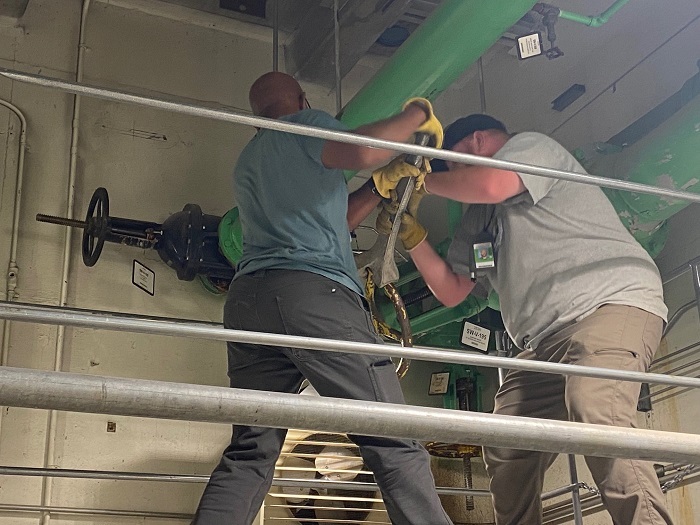 Hanford Mission Integration Solutions staff members Kyle Tilley, left, and Frank Ellis isolate water pipes on the Hanford Site.
Taking the facilities offline included disconnecting temporary substations that once provided electricity. HMIS crews also removed meters and other electrical equipment that powered mobile trailers, as well as telecommunications cables.
“Our water and sewer utilities team encountered several challenges when disconnecting the aging lines but came up with required solutions for each,” said Todd Synoground, HMIS vice president of Infrastructure & Site Services. “I commend our teams for their dedication to safely and successfully completing this job over the last six months.”
-Contributor: Robin Wojtanik
WEST VALLEY, N.Y. – Workers have successfully deactivated another high-hazard cell of the Main Plant Process Building, moving the facility closer to demolition, an EM 2022 priority at the West Valley Demonstration Project (WVDP).
EM and cleanup contractor CH2M HILL BWXT West Valley (CHBWV) finished deactivating the Ventilation Wash Room (VWR), which housed a ventilation "scrubber” that removed airborne particulates resulting from fuel reprocessing operations that ceased in 1972.
The scrubber will be removed during the Main Plant demolition. Crews have prepared that equipment for removal.
“The safe execution of this work is due to the combination of extensive planning, deliberate speed and use of worker feedback throughout the deactivation,” said Steve Bousquet, EM WVDP federal project director for the Main Plant demolition. “The WVDP team continues its strong commitment to safely protecting its workers, the public and the environment while reducing legacy risks at the site.”
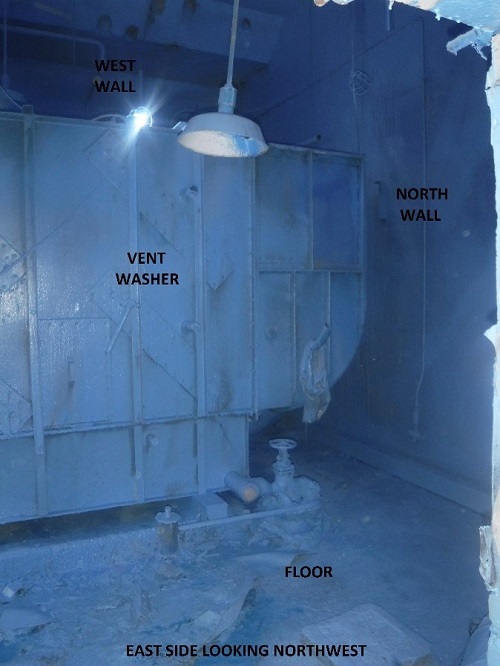 |
|
Workers have completed the deactivation of the Ventilation Wash Room within the Main Plant Process Building at the West Valley Demonstration Project. The cell housed a ventilation “scrubber” that removed airborne particulates resulting from fuel reprocessing operations that ceased in 1972. A crew applied fixative to the room for contamination control to prepare for the Main Plant demolition. |
Successful deactivation of the Vent Wash Room comes on the heels of another safe deactivation of a cell within the Main Plant that reduced radiological hazards to support the facility’s demolition. Crews recently overcame unique challenges and finished deactivating the Product Purification Cell-South, a highly contaminated cell resembling an elevator shaft. For the Vent Wash Room deactivation, project leaders incorporated feedback from workers, further enhancing safety. The workers recommended performing the cleanup remotely to keep potential exposure to radiation as low as reasonably achievable.
Operators created openings in the cell to allow for a diamond wire saw to be placed outside the cell. Workers made short trips into the cell to adjust the diamond wire as they cut through a ventilation duct for removal. As a result, the operators limited their potential exposure.
“Working in the Vent Wash Room was physically challenging when you include radiological and industrial hazards, layers of protective clothing, limited mobility and COVID protocols,” said Tom Dogal, CHBWV facility disposition manager. “This crew used lessons learned to enhance safety, improve efficiency and reduce exposure to job-related hazards. They put their collective knowledge into practice.”
During fuel reprocessing activities in the 1960s and 1970s, several areas within the Main Plant, including the product purification and chemical process cells, and a fuel-receiving and storage facility, sent exhaust to the Vent Wash Room through the ductwork. The exhaust was then directed to a ventilation exhaust cell where it was filtered before being discharged to the plant’s stack.
-Contributor: Joseph Pillittere
|



